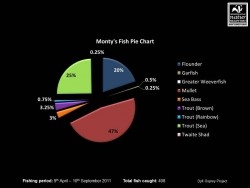Last week's blog was about those special adaptations that ospreys have that make them so good at specialising purely on a piscatorial diet. This week we look in more detail at exactly which species of fish the Dyfi ospreys eat and what ratio of their diet each species makes up.
This morning my work colleague Alwyn and I were invited to give a presentation in Trawsfynydd (near Porthmadog), to the annual North Wales Fisheries Conference, specifically about ospreys and fish predation. Not an easy task you may think, as these guys were there to discuss and explore ways of managing and mitigating against fish predation. Here's the video I had prepared for the conference to illustrate the main fish species that Monty catches (watch in Full Screen and 1080P HD for best results!):



